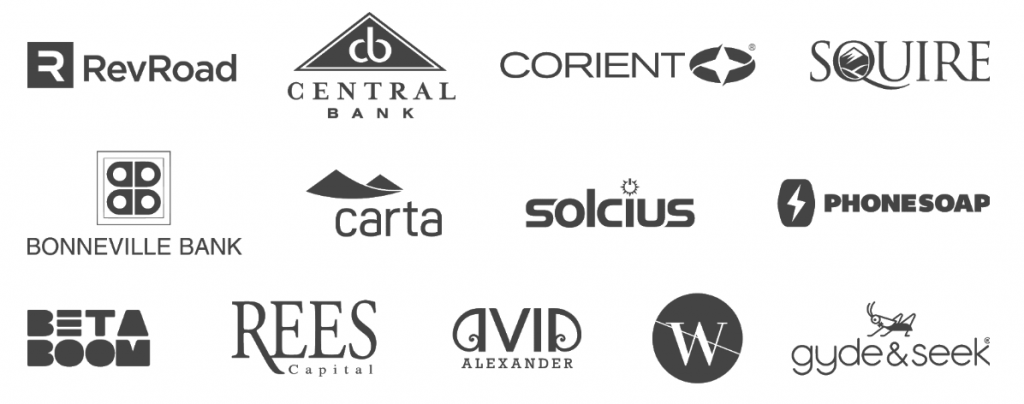RevRoad today announced its expansion to Florida with Tony Allen as President.
Continue readingRevRoad Announces 36 Semi-Finalists for 6th Semi-Annual Entrepreneur Competition Sponsored by Central Bank
Utah’s biggest Entrepreneur Competition features rising startups that will lead the future.
PROVO, Utah — RevRoad, a Utah business accelerator, today announced the 36 semi-finalists for the 6th semi-annual Entrepreneur Competition sponsored by Central Bank. The competition will be held at 10:00 AM on Saturday, March 25, 2023, at the Utah Valley University Keller Building. With $10,000 on the line, these companies are eager to showcase their businesses to Utah’s finest investors, mentors, and executives.
The competition semi-finalists are:
The semi-finalists will compete for the following prizes:
- $10,000 Central Bank Grand Prize
(Cash prizes are not tied to an investment or equity.) - $2,500 cash for the Runner-Up
(Cash prizes are not tied to an investment or equity.) - $1,000 cash for the 3rd place prize
(Cash prizes are not tied to an investment or equity.) - $1,000 cash prize for the Fan Favorite
(Cash prizes are not tied to an investment or equity.)
RevRoad encourages the public to vote for their favorite company as part of the fan favorite award. They are also invited to attend this free event.
Further detail at ecomp.revroad.com. For media inquiries, interviews or additional information, please contact RevRoad PR Specialist Brittany Ouimette at brittany.ouimette@revroad.com or by calling 888-920-7623.
About RevRoad
RevRoad is a venture services firm that focuses on helping entrepreneurs succeed. They empower portfolio companies to maximize profitability, get to market faster and create a solid foundation for their venture by packing their team with experts for up to 24 months. RevRoad team members work shoulder-to-shoulder with founders of developing companies to provide everything they need to scale their businesses faster. Visit revroad.com to learn more and apply for the accelerator program.
5 Qualities Every Entrepreneur Should Exemplify
Being an entrepreneur is hard. Here’s about 5 qualities every entrepreneur should embody to better chances of success.
1. Hands – Passion
2. Heart – Creativity
3. Humility – Teachability
4. Humor – Lightheartedness
Mastering Investor Pitches (pt 3)
Written by: Seth Robinson
Every story has a beginning, middle and end. Put another way, a premise, a conflict, and a resolution. Point is, even with a compelling story you won’t go very far unless the story is easy to follow. Structure lubricates understanding. The best structure I have found for investor pitches is Guy Kawasaki’s 10-20-30 deck.
10-20-30 deck stands for 10 slides, 20 minutes, 30 point font. The ten slides are (1) Title, (2) Problem, (3) Unique Value Proposition, (4) Underlying Magic, (5) Business Model, (6) Go-to-market Plan, (7) Competitors, (8) Team, (9) Projections & Metrics, (10) Status, Accomplishments & Timeline.
These ten subjects give potential investors a comprehensive view of your company. They cover all the basics investors will need to know before they can consider further engagement. These slides function as the jump off point for additional engagement. The order of these slides isn’t important, and I would highly recommend changing the order to compliment your story.
Twenty minutes means you must be quick and deep. A quick and deep overview is always possible, but not usually easy. Refining your story will take practice, work and feedback from others. For practice, look into your local 1MillionCups groups. Investor pitch feedback is what those groups exist for!
Keep the presentation compelling, not exhaustive. If you do it right, investors will have follow up questions. An absence of questions means an absence of interest. In other words, the story isn’t compelling, or they had trouble following. Investor questions engage potential investors. It draws them into your story. Leave the bulk of your allotted time for their questions. The pitch will hook them; their questions will bring them on board. Do not vary from the 20 minutes! You can keep it to this time.
Thirty point font means don’t use any font less than 30. This is more important than it seems! Thirty point font forces judicious use of slide space. It helps drive home important points, but keeps you focused on the story. With 30 point font, you can’t just read your slides, because there simply isn’t much text (don’t read slides anyway. Bad form). Thirty point font complements a quick and deep approach because it doesn’t allow you to be exhaustive.
Also, investors tend to be older, and they can’t see small font. An unreadable slide is a fast way to lose interest.
The 10-20-30 deck provides the structure that makes your story easy to follow. This has become an industry standard of sorts, and most investors expect this type of presentation. Use this to your advantage. Do not focus on the presentation! Use the presentation to focus on your story. Every slide should be telling the story of your traction, quick and deep, compelling and easy to follow.
Don’t focus on your idea. And don’t lose your story in your story’s structure (or slide deck). A compelling and easy to follow story maximizes investor engagement. Making a case that you are the smartest person in the room is not only problematic and difficult, but even if successful, it won’t have the effect you think it will. Stories do have that effect.
Mastering Investor Pitches (pt 2)
When assessing startups, look at the problem, look at the customer, and look at the market. The combination of those three categories will show you traction. There are many different definitions of traction. Whichever one you use, you’ll be in good shape. For today, we’ll go with: traction–your startup’s evidence of success within the market.
So let’s talk about what traction looks like in a story: movement.
Can you move people? Do people care about what you are doing? Do they sign up for more information? Do they gasp and smile once they “get” what you are doing? Do people want to give you money but can’t because you don’t have a product?
The more people you can move, and the more profoundly you can move those people, the more traction you have. This is the evidence investors look for in the context of problem, customer, and market. This is how investors identify opportunities.
Traction is the compelling force behind the story of your venture. In a presentation, the story is how you make traction matter. Here are some real investor stories of companies. Which do you find most compelling?
“I am not a marketer or sales person, but with the few sales I have achieved, people come back and buy more. One in four customers returns and on average and buys 3x more the second time. Over half of our site’s new visitors come from entering the URL, not from search results or ads. How do they know our URL? People are talking, not searching. The product is sticky. I just need more places to stick it.
“I thought people would use this product because it was convenient. They tell me they actually buy it to avoid interacting with our competitor! It turns out our go-to-market strategy allows us to not only avoid 90% of our competitor’s overhead cost, but charge 3x the markup and get 8x more repeat customers. Help us rescue customers from our competitors!”
“This market doesn’t resist change, it’s simply been skipped over for 30 years. When we apply basic technology used elsewhere, and apply it to this niche, we see a 100% sales conversion rate even though our price point is 50% higher than their current costs. Without marketing we have more inquiries than we can service. We don’t need help with sales, we need help with onboarding!”
Each example shows traction. Proof of traction builds investor confidence in the opportunity; the story builds investor confidence in the entrepreneur. Good business models are built on good information, not on good ideas. Investors invest in people, not ideas.
How to Give the Winning Pitch
Written By: A.J. Rounds
As a member of the founding team at RevRoad, I’ve reviewed hundreds of pitches and learned a few things that may be helpful for you as an entrepreneur.
Bring Your A Game
When you pitch your company to venture capitalists, investors, or other partners, bring your A game. I’m not just talking about the 10/20/30 rule coined by Guy Kawasaki (although, also extremely helpful). I’m referring to answering crucial questions in your presentation.
Pitching is an art, and there are few who do it well. Out of the entrepreneurs I’ve seen pitch, about 25% present extremely well, while 20% pitch on an average level and give the basics. The remaining 55% need to read this article.
My goal in writing this is to help you secure the resources and partnerships (in some cases Venture Services) you need to succeed.
What should you include in your pitch?
Let’s dive in.
Know your customer
Before you begin building your pitch, answer the following questions.
- Do you know your audience?
- Have you identified your target market by needs, demographics, geography, and ability to pay?
If not, that’s step 1. It is also helpful to understand what their experience level is when it comes to using your product or service. What do they currently say about your company?
Now you are ready to begin constructing your pitch.
Problem/Solution
Can you explain what you do or offer in one sentence? If not, please practice.
Frame it in terms of the problem your target market has and how you solve it.
Additionally, ask yourself if your market is big enough. Is your solution good enough? Putting your audience through a long, tedious exercise of trying to understand what your company does, the problem you solve, and how you are different from other options in the market will not help you.
Make it quick, easy, and obvious.
Revenue Model, Projections, Timeline, & Financial Outlook
Remember, often you are pitching to an audience that is financially minded. Be sure to spend time on your business model or revenue model.
Questions you should answer include:
- What is your revenue model? Is the revenue recurring (preferred)?
- Do you have multiple streams of revenue?
- What is the price point of your product and corresponding profit margins?
- What is the lifespan of your product or service?
- How have you funded your business to this point?
- Who else is on your cap table?
- What does an exit look like for you and when?
- What is your current valuation?
- Are your financials and projections realistic?
- What is the timeline to revenue milestones?
Traction
One of the things I expect to hear about when listening to a scalable company pitch is traction achieved.
Maybe that’s a revenue number. Or, if you are pre-revenue, maybe that traction number equates to followers, an email list, or even submitted pre-orders.
Market Size
Closely related to traction is your market size. You should also be very familiar with this information.
Please don’t present an unrealistic TAM when pitching your business. I often hear the statement, “If I can just convert 1% of the population of China or the U.S. market, then we will have achieved our goals.” This is an instant turnoff for educated investors or partners.
Talk more about your Serviceable Obtainable Market (SOM) or what portion of the market you can realistically reach.
Defensibility & Competitors
In your pitch, include how your product or service is unique and defensible. Do you have intellectual property or patents filed?
Risks are mitigated when your closest competitor can’t easily copy your value proposition—which brings me to competition.
Who are your competitors? Are they well-funded? Do they have large market share? Where might your product overlap with theirs? There are many templates available that can help you create a competitor analysis report.
Team
Discuss your team. Who are you? Who are your teammates? Why did you get into this vertical?
Talk about your successful exit(s) or epic failure(s). Maybe even both. This shows you’re an experienced entrepreneur that understands the roller coaster ride of entrepreneurship. If done right, talking about these items will give you credibility and show your passion for your company.
If you have an advisory board, which is highly recommended, discuss who those individuals are and the value they bring to the table.
It’s also helpful to mention who’s working full time in the business and who is not. This is critical. At RevRoad specifically, we seldom work with companies that don’t have at least one founder working full time in the business.
Summary and CTA
Include a concise summary and clear call to action as the last slide of your presentation and boom, you are ready to pitch!
As someone who listens to entrepreneurs pitch for a living, I recommend that you follow these guidelines. Your chances of a successful pitch will skyrocket.
Whatever the pitch event, be it the annual Entrepreneur Competition hosted by RevRoad, a pitch to become a RevRoad portfolio company, or a community pitch competition like the Silicon Slopes Tech Summit Competition, incorporate these tips and you’ll nail your presentation.
Good luck!
Applications to join RevRoad close on April 30, 2020.
Apply to RevRoad here
Learn more about RevRoad here
RevRoad Collaborates with Tangible to Provide E-Commerce Education for Entrepreneurs
In a time where marketing outlets are changing rapidly, it’s important for business owners to have a current educational foundation. Tangible School specializes in e-commerce education. They provide two 5-week education tracks with classes taught in-person by industry professionals. We are excited to announce that as of today, April 16 2020, RevRoad has joined forces with Tangible to provide up-to-date education for entrepreneurs.
Continue readingNetwork = Networth
You’ve probably heard the saying, “It’s not what you know, it’s who you know.” So, let’s talk about the importance of networking. Networking is crucial in….
Continue readingRevRoad’s Announces Annual Entrepreneur Competition
PROVO, Utah — On Saturday, March 21st , Utah County’s top entrepreneurs will all gather at RevRoad HQ for the opportunity to pitch their game-changing, scalable company to panels of Utah’s most successful.
Often, the most important moment in an entrepreneur’s life is pitching their business to an investor (techcrunch.com). RevRoad’s Annual Entrepreneur Competition helps companies learn how to pitch their business with confidence and provides an opportunity to network.
Each participant must complete a thorough application process as well as 2 rounds of live pitches for a panel of 24 judges—gathered from top business and university leaders. Using criteria including target market, problem/solution fit, team and advisors, leadership, traction, competitive advantage, financials and more, the judges will select the top 3 as finalists. All applications for the pitch competition are due Friday, March 6, 2019 by 11:59 pm.
The three winning finalists will receive prizes:
- $10,000 cash for the Champion
(Cash prizes are NOT tied to an investment or equity.) - $2,500 cash for 2nd Place
(Cash prizes are NOT tied to an investment or equity.) - $1,000 cash for 3rd Place
(Cash prizes are NOT tied to an investment or equity.)
This event is free and open to the public, so the community will also get the chance to award a cash prize. The company that gets the most audience votes will receive:
- $1,000 as the Fan Favorite
(No conditions or terms of use are associated with this prize.)
Competition sponsors are:

###
For media inquiries, interviews or additional information, please contact RevRoad CMO A.J. Rounds at aj.rounds@revroad.com or by calling (801) 368-1823.
About RevRoad
Did you know 9 in 10 new innovations fail in the marketplace? RevRoad focuses on helping you, the entrepreneur, succeed. RevRoad accepts 3–4 companies per quarter, if chosen you work side-by-side with us for two years. Along the way, you’ll experience everything you need: a mentor, networking opportunities, and key service deliverables. The RevRoad model is a venture services model to better meet your needs.
RevRoad’s Portfolio Supports Two Companies in the Startup World Cup Regional Finals
On Thursday, January 30th, Startup World Cup held their final round for the Utah region. This highly competitive pitch-off took place on the main stage at the Silicon Slopes Tech Summit . After reviewing over 100 applicants, 10 companies were selected to advance to the final round. Among the finalists were Hallo and Savology, two outstanding companies in RevRoad’s portfolio.
The judges panel highlighted some of Utah’s most respected including:
Vanessa Quigley: Chatbooker-in-chief at Chatbooks.com
Karl Sun: Co-Founder and CEO at Lucid Software
Sam Stoddard: CEO at SimpleCitizen
Gavin Christensen: Founder and Managing Partner at Kickstart Seed Fund
Kat Kennedy: Chief Experience Officer (CXO) at Degreed
Each company had the chance to present a 5 minute pitch followed by a 2 minute Q&A with the judges panel. The excitement and anticipation from each participating company was evident.

Third to present, Hallo brought energy and competition by including their organically grown audience numbers which land at 10,000 new weekly users and 400,000 total users. They continued to impress the judges by including a live product demonstration of their unique live language learning platform.
Immediately following Hallo, Savology took the stage. Highlighting growth since their December launch, Savology outlined their solution for the lack of financial direction among millennials and rising generations.

“This is great representation from RevRoad. In addition to making a good showing in front of the judges, each company that participated used the event as an opportunity to meet with other investors and business leaders in the Utah entrepreneurial ecosystem.
Derrin Hill – CEO at RevRoad
Both Hallo and Savology demonstrated extreme professionalism as they delivered their polished 5 minute pitches and gave exceptional answers during the judges Q&A portion. Though neither were selected to progress to the Grand Finalé event in Silicon Valley, both received incredible feedback and exposure through their participation in the event.
RevRoad is proud of the hard work, grit and innovative drive of the entrepreneurs in our family of companies, and we look forward to big things in the future.
Congratulations to the competition winner, Axon Optics––we wish them luck at the Grand Finalé event. A special thanks to Silicon Slopes, Startup World Cup, the judges panel, and supporting community groups for including Utah’s startup community in this competition.
Learn more about Hallo here.
Learn more about Savology here.
Have a startup? Learn more about how to become part of RevRoad’s portfolio here.









